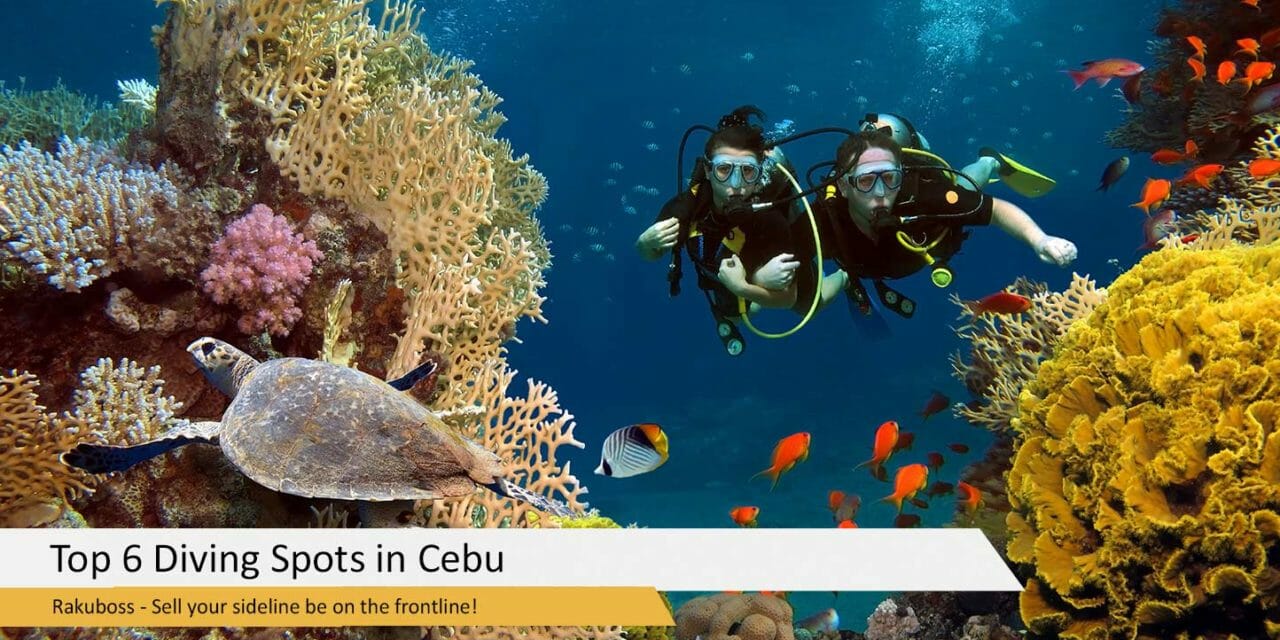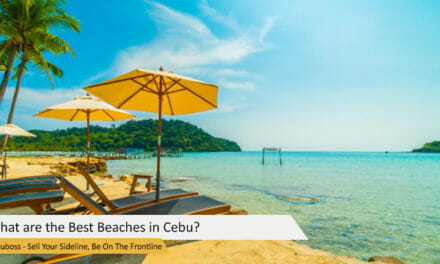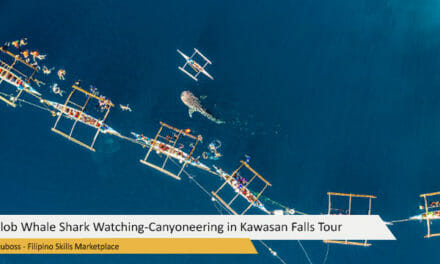Cebu is known for its vibrant and cultural city, as well as its undoubtedly breath-taking natural attractions. The islands of Cebu are one of the most underrated yet beautiful bodies of water in the whole country. They are hidden treasures with intriguing gems you can only see when you dive into these cerulean waters.
You’ll be greeted by unique underwater creatures, various marine discoveries, and that thrill of exploring the deepest secrets of the seas. Now, there are at least 8 beautiful diving spots you can check out in Cebu. The province definitely has plenty of room for every kind of diver.
Find out which of these islands is the kind of place for the adventure you’re looking for:
Malapascua Island
Malapascua is among the most popular diving spots in Cebu that’s also recommended for beginners. So if you want to embark on an underwater journey for the first time in Cebu, here’s the best spot for you. The area has numerous diving schools and tour groups around to guide you through your visit.
Malapascua is located at the far north of Cebu’s main island. It takes a 4-hour bus ride from Cebu City’s North Bus Terminal. You’ll be dropped off Barangay Maya in Daanbantayan Town where it takes another 45-minute boat ride to get to the main Malapascua area.
Many tourists sign up for tour and diving guides just to experience the thrill of swimming with the Thresher Sharks in Malapascua’s Monad Shoal. That is what this island is most famous for. After all, it’s not usual to say you have been in the waters with these huge sea creatures.
Don’t underestimate this island as just a spot for diving with sharks, though. Malapascua is host to the following as well:
- Untouched coral gardens
- Fascinating wrecks
- Pristine reefs
- Amazing sandy muck dives
- Night dives
- Wall dives.
You’ll also be amazed by the different species you can spot in the waters of Malapascua such as the following:
- Manta rays
- Marble rays
- Devil rays
- Turtles
- Whale sharks
- Sea snakes
- Frogfish
- Blacktip sharks
- Harlequin shrimp
- Xenon crabs
- Sea stars
- Blue Ring octopus
- Ghost shrimp
- Bobtail squid
It’s the underwater heaven our young selves had always envisioned to be.
Mactan Island
Another hot diving spot in Cebu, Mactan Island is a small island that’s separated from the Cebu mainland but is linked by bridges in the Mactan Channel. It is located on the east of Cebu which you can get to via boat.
Just like Malapascua, Mactan Island is welcoming to new divers or first-time island visitors of Cebu. It is also conveniently situated just on the same island as the Mactan-Cebu International Airport, so it won’t be such a hassle getting there to relax and swim with different fish.
As soon as you land in Cebu, you can just run off to the island, get your feet covered with sand and your skin exposed to the glory of the tropical sunlight. Mactan has a diverse marine scene with different marine sanctuaries, spectacular underwater caves, colorful corals, and adorable fish such as tuna, surgeonfish, and squirrelfish.
Diving in Mactan is just fulfilling with its two major wrecks, seagrass beds, caves, steep slopes, coral gardens, deep walls, and sheer drop-offs. It offers both thrill and relaxation in one. Beginners have easy access to instructors while much more experienced divers have plenty of spots to discover around the island as well.
Capitancillo Island
Another island in the Northern Cebu, Capitancillo is located in Bogo City. It can be reached by a 3-hour bus ride from Cebu City and a 20-minute boat ride from the Marangog Cove. The island is not as well-known as Malapascua and Mactan, so you can enjoy a peaceful day-dive session in this area. With 50 feet diving depth and normal visibility of 20-30 meters, you’ll surely enjoy Capitancillo if you’ve already been diving for a while.
Capitancillo has a whole rainbow of corals, various-sized shoals with different marine species, plenty of reef fish, and sharks as well (white-tip and grey reef). The island also has an interesting historical background. The islet’s name was even derived from the American Navy Captain Cillo.
During World War II, he got stranded on the way to this remote island. There’s hardly any land in the area of Capitancillo. It’s just the sand, ruins of an old structure, and the clear turquoise waters surrounding it. There’s nothing else for you to do but dive into its waters and tour its deepest wonders.
Moalboal
Moalboal is a town just two hours away from Cebu City and is on the southwest coast of the province. The entire region is home to specific diving spots that are starting to gain global recognition as well such as the Pescador Island. It is an islet on the Tañon Strait and is a protected marine park.
The islet is home to hammerhead sharks and the popular Sardine Run. The sardines hover about 30 meters off the Moalboal coast, right in front of the Savedra Dive Center and just around the Panagsama Beach. This side activity is free, too. It would be a memorable experience to try it.
This sanctuary has a depth of more than 600 meters, and sardines are not the only species that live around such a massive aquatic space. This area is diverse with different species of reef fish and other creatures. Here are a few swim buddies you’ll meet under the waters of Moalboal:
- Whitetip reef sharks
- Jacks
- Thresher sharks
- Schooling barracudas
- Lionfish
Expect Moalboal to have several dive shops for you to get your gear and even an instructor should you need one. Moalboal also has Basdasko, a white beach that is a perfect place to chill and just bask under the sun. So if you have friends or family coming with you who are not really into diving, they can still share your journey to Moalboal and have their own fun.
The Olango Group of Islands
The Olango Group of Islands has 6 satellite islets which are the following:
- Sulpa
- Gilutongan
- Nalusuan
- Caohagan
- Pangan-an
- Camungi
The Olango Island Group is both Lapu-Lapu City and Cordova’s territory, making it such an accessible attraction. Olango used to be just known for its wildlife sanctuary and birdwatching. However, it’s definitely more than just those things. The island has tall palm trees swaying to the sea breeze, serene beaches, craggy cliffs, intertidal mudflats, and striking corals.
The clear waters also lead to a diverse underwater kingdom, making scuba diving in the area even more exciting. The island has some of the deepest wall dives in the entire Visayas, too. Here are the noteworthy diving sites on the island:
Nalusuan Island
Nalusuan Island 20-40 minutes away from Mactan via boat. The diving spot on the island starts at a shallow point which is also good for snorkeling. Then it leads down a sandy sloped wall. The seabed is magnificently lined with soft and hard corals and sponges.
Since Nalusuan is a dive sanctuary, its marine life is preserved from fishing interests. The marine biodiversity in this area is just too good to not put under strict protective measures. Here are some impressive species you’ll see under the waters of Nalusuan:
- Snappers
- Sweetlips
- Triggerfish
- Angelfish
- Parrot fish
- Cuttle fish
- Sea turtles
- Barracudas
- Natural reef fish
- Stingrays
- Groupers
All scuba divers are welcome from beginners to experts. Day diving is highly advised, and there are side activities such as snorkeling and island hopping tours hosted around the island as well.
Kansantik
Kansantik is an underwater mountain right at the center of Olango Channel. The site has a rich marine life, untouched reefs, different dives, and generally just a clean shore stretch. This beautiful diving site is recommended just for the most experienced scuba divers out there. Coming in small groups is also highly advised due to the strong current.
The maximum depth of Kansantik is greater than 165 feet with guaranteed visibility of up to 130 feet. The dive spot has whip corals around, as well as large sponges, snappers, schools of various fish, and Moorish fish will be swimming along with you.
Mabini Point
Mabini Point is situated at the northern tip of Olongo Island, also known as the Tingo Point. You can reach the area via boat from Mactan Island in about 15-20 minutes. The diving site is for advanced divers who are already knowledgeable of fierce surges and unpredictable currents.
The maximum depth is 130 feet whereas the visibility is up to 30 meters. This is the perfect site for professional divers who want to see bigger pelagic creatures. Hammerhead sharks can be usually spotted here while Whale Sharks also make some appearances sometimes, too.
The shallow waters have nothing to show, so you have to get down soon to 35 meters or 115 feet to unravel the hidden treasures of that diving spot.
Baring Diving Site
Baring Diving Site is located in the village of Baring in the northern end of Olongo Island. Via boat, it is just 15-20 minutes away from Mactan Island. This site is known for its marvelous drop-offs, giant caves, and steep slopes. The wall begins at 60 feet or 20 meters and drops down to 220 feet or 73 meters before gradually disappearing on a slope.
Once again, there are strong and unpredictable surges and currents here. The visibility is also up to 30 meters. This site is only for seasoned divers who know how to manage these extreme conditions. Another nice thing to look forward to in Baring is the sightings of the following species:
- Whitetip sharks
- Grey reef sharks
- Hammerhead sharks
- Thresher sharks
- Barracuda
- Tuna
- Snappers
- Jacks
Santa Rosa
A trip via a native outrigger boat makes the journey to Santa Rosa about 15-20 minutes. The site has a maximum depth of 130 feet, starting at a 9-meter dive on a sandy bottom going on a drop-off at 15 meters until it descends to 50 meters. The region is abundant in marine life, hence you’ll see a wide range of fish species such as the following:
- Fusiliers
- Catfish
- Jacks
- Snappers
- Sweetlips
- Reef fish
Take note that the visibility in this site is 100 feet over the drop-off point. However, it is muddy on the initial diving points. The currents are strong but not as bad as the other sites above. Still, Santa Rosa’s currents are still more predictable. This makes beginners allowed to dive here as long as they have a divemaster with them.
You can also go snorkeling between 9 meters to 12 meters on the reef flat of the site. You’ll need a boat or banca to take you over there due to the muddy well and harsh currents, though.
Gilutongan Sanctuary
Gilutongan is further down south of the Olango Island, almost close to the tip. Facing Mactan Island, this dive spot has a reef border from 5 to 22 meters with vibrant corals and diverse species of fish. The water is also almost transparent, making topnotch visibility. It may not be as common as the other sites above, but Gilutongan is a nice peaceful place for chill divers who just want to unwind.
Talima Sanctuary
Talima is located at the Tingo Shark Point. This diving site’s appeal is not based on slopes, depth, etc. It is simply rich in different species, both fauna and flora as well. You can have sightings of painted Anglerfish, squirrelfish, soldierfish, jacks, batfish, lizard fish, snappers, sweetlips, Moorish fish, fusiliers, and catfish.
The Olango Group of Island is generally for scuba divers who are on advanced levels already. Kansantik alone is open water with such limited visibility, as well as wild currents and surge. Those who are even bringing recording equipment aren’t allowed to carry heavy materials as it could get really harsh there.
The other sites also have the same character. However, the mountain rises and diverse pelagic species in the entire island are all worth it (just make sure you are an experienced diver, of course).
Hilutungan Island
Hilutungan Island is a marine sanctuary that’s an ideal site for diving beginners and snorkelers. The area is the oldest protected area in all of Cebu. So you’ll be able to notice how well-preserved the marine species in the area are. Despite the high tourism and divers coming in, Hilutungan remains a heaven of marine wonders and haven for different creatures.
The waters on the island are shallow. That’s why scuba diving has become the ultimate solution to get closer and deeper into the beauties under the water of Hilutungan. There are diving centers all over Cebu that offer diving packages for Hilutungan. They’ll provide your gear, arrange your transportation, and guide you all the way into the trip.
The visibility in the site is up to 35 meters deep while the waters also have a warm temperature that’s favorable for divers. However, you’ll feel the intense heat of the sun out of water since it’s usually 27-29 degrees Celsius.
The current in Hilutungan is not an issue in the area, unlike the Olango Island sites. It is surrounded by other islands and is part of Visayas’ shallow waters. However, there are walls for scuba divers to dive deeper into for a full journey under the waters of the island. The slope dive is between 10-25 meters deep.
Conclusion
There’s definitely plenty of diving sites out there in Cebu, and if you’re an experienced diver looking to expand their experiences, this list could be a nice checklist for you. The same goes for beginners; these marine kingdoms are worth getting those lessons or trying the beginner sites more than once to finally reach those spots with more pelagic discoveries to offer. Should you need someone to help you get to these areas, you can hire your own personal tour guide on Rakuboss.
It’s a marketplace for many tour guides who know all the local ins and outs and will give you such an immersive travel experience for an affordable and even negotiable rate. Check out the site and get the assistance you need.






